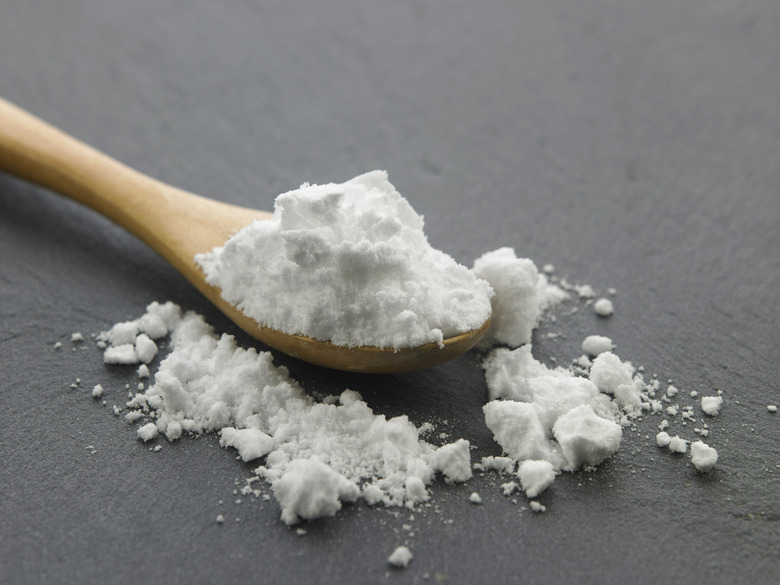Bases Used As Common Household Products
To a chemist, a base is an electron pair donor. In more familiar terms, a base is the alkaline opposite of an acid; when the two mix, they neutralize one another. The logarithmic pH scale measures a substance's acidity or alkalinity, and chemists classify anything with a pH greater than 7.0 as a base. If the term "base" seems obscure, the substances themselves are common. Virtually every household uses bases regularly.
TL;DR (Too Long; Didn't Read)
Common household chemical bases include ammonia, baking soda and lye.
Baking Soda
Baking Soda
Baking soda, or sodium bicarbonate (NaHCO3) has a pH of 8.3, higher than distilled water's pH of 7.0. Baking soda makes biscuits rise, freshens drains and keeps teeth clean. Sodium bicarbonate is safe to touch. Mix a teaspoon of it into a cup of water and feel the slippery texture the water now has; that soapy feel is characteristic of bases. Drinking a few pinches of baking soda dissolved in water will neutralize some of the excess acid in the stomach. It also makes a mildly abrasive and non-toxic cleaning agent.
Borax: Cleaning and Pest Control
Borax: Cleaning and Pest Control
Borax, or sodium tetraborate (Na2B4O7*10H2O), once helped preserve mummies in ancient Egypt. Now it keeps clothes looking fresh and kills household pests. Its pH of 9.2 means it's 920 times more alkaline than pure water. Borax contributes an oxygen ion to water to form hydrogen peroxide (H2O2) in solution, making it a disinfectant and mild bleaching agent. Avoid handling borax directly or for too long, as it can cause skin irritation. Borax is mildly toxic if ingested.
Milk of Magnesia (Magnesium Hydroxide)
Milk of Magnesia (Magnesium Hydroxide)
This common antacid and laxative got its milky name from its opacity. Magnesium hydroxide [Mg(OH)2] has a pH of 10.5. Commercial preparations of milk of magnesia use mint or fruit flavors to conceal the bitter taste that's characteristic of alkaline substances.
Ammonia, Enemy of Dirt
Ammonia, Enemy of Dirt
The term "ammonia" refers both to an irritating gas (NH3) and to the cleaning product (NH4OH) that results from dissolving ammonia in water. Household cleaning ammonia has a pH of 11, or 50 times stronger than that of milk of magnesia. It's a powerful household cleaner that cleans virtually any surface of dirt and grease. Even a bottle of cola may contain minute quantities of ammonia, as some sodas use ammonia to process coloring agents. Never mix ammonia cleaners with other cleaning products; ammonia cleans well enough on its own, and mixing it with other products could produce toxic vapors.
Lye: Clog Buster
Lye: Clog Buster
The strongest base commercially available cleans ovens, unclogs drains, and makes a Southern breakfast better. Lye, or sodium hydroxide (NaOH), is a major component in drain cleaners; it liquefies clogs so they can wash through the pipes. Caustic lye-based oven cleaners cut through baked-on material in the oven. A soak in lye helps turn corn into grits, which are neither caustic nor alkaline. Keep lye from any exposed skin; it can cause severe chemical burns.
References
- New York State Department of Health: The Facts About Ammonia; July 2004
- University of Georgia: Making Grits – A Southern Staple; Valerie Blair; Dr. Frank Flanders; July 2004
- Georgia State University: Sodium Bicarbonate
Cite This Article
MLA
Whitney, Lauren. "Bases Used As Common Household Products" sciencing.com, https://www.sciencing.com/bases-used-common-household-products-8107632/. 16 April 2018.
APA
Whitney, Lauren. (2018, April 16). Bases Used As Common Household Products. sciencing.com. Retrieved from https://www.sciencing.com/bases-used-common-household-products-8107632/
Chicago
Whitney, Lauren. Bases Used As Common Household Products last modified August 30, 2022. https://www.sciencing.com/bases-used-common-household-products-8107632/
